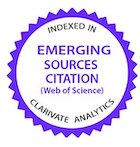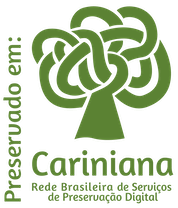Efeito da nutrição materna no terço final da gestação sobre a composição corporal da progênie ao abate
DOI:
https://doi.org/10.1590/1809-6891v24e-74730EResumo
O objetivo do estudo foi avaliar os efeitos da nutrição materna no terço final da gestação sobre o desempenho ponderal e a composição corporal da progênie. Foram utilizados 41 novilhos de vacas submetidas a diferentes níveis nutricionais durante o terço final de gestação: 13 vacas sem suplementação sob restrição nutricional (RES); 16 vacas suplementadas para atender 100% das exigências (REQ); 12 vacas suplementadas para atender 150% das exigências (HIGH). O delineamento experimental foi inteiramente casualizado. O desempenho da progênie não foi influenciado pela nutrição materna na gestação (P > 0,05), porém, animais RES se sobresaem em períodos desafiadores, enquanto que os REQ e HIGH desempenharam melhor em ambientes nutricionalmente favoráveis. A nutrição materna no terço final da gestação não influenciou a participação dos componentes não carcaça (16,42%) e órgãos internos (3,17%). O peso relativo do rúmen foi maior nos novilhos RES e HIGH (2,48%) em relação aos novilhos REQ (2,24%), resultando em maior participação do trato gastrointestinal (8,25 vs 7,63%, respectivamente). As características quantitativas da carcaça foram semelhantes entre os tratamentos (P > 0,05), com peso médio de carcaça quente e rendimento equivalente a 304,28 kg e 57,80%. A participação dos cortes primários dianteiro, lateral e traseiro foi de 39,22, 10,64 e 50,67%, respectivamente. Diante do exposto, concluímos que a nutrição materna na gestação afeta a formação fetal de modo a modificar a composição corporal e consequentemente o potencial produtivo dos descendentes.
Palavras-chave: órgãos vitais; peso de abate; rendimento de carcaça; trato gastrointestinal
Downloads
Referências
Reynolds LP, Caton JS. Role of the pre- and post-natal environment in developmental programming of health and productivity. Molecular and Cellular Endocrinology. 2012; 354 (1): 54-59. https://doi:10.1016/j.mce.2011.11.013
Klein JL, Machado DS, Adam SM, Alves Filho DC, Brondani IL. Efeitos da nutrição materna na gestação sobre a qualidade da progênie - uma revisão. Research, Society and Development. 2021; 10 (2): e45710212654. http://dx.doi.org/10.33448/rsd-v10i2.12654
Brameld JM, Greenwood PL, Bell AW. Biological Mechanisms of Fetal Development Relating to Postnatal Growth, Efficiency and Carcass Characteristics in Ruminants. In: Greenwood PL, Bell AW, Vercoe PE, Viljoen GJ (editors). Managing the prenatal environment to enhance livestock productivity. Springer Dordrecht Heidelberg London New York; 2010. p. 93-120. https://doi.10.1007/978-90-481-3135-8
Reynolds LP, Borowicz PP, Caton JS, Crouse, MS, Dahlen CR, Ward AK. Developmental programming of fetal growth and development. Veterinary Clinics of North America: Food Animal Practice. 2019; 35 (1): 229-247. https://doi.org/10.1016/j.cvfa.2019.02.006
Duarte MS, Gionbelli MP, Paulino PVR, Serão NVL, Martins TS, Tótaro PIS, Neves CA, Valadares Filho SC, Dodson, MV, Zhu M, Du M. Effects of maternal nutrition on development of gastrointestinal tract of bovine fetus at different stages of gestation. Livestock Science. 2013; 153 (1): 60-65. http://dx.doi.org/10.1016/j.livsci.2013.01.006
Da Cruz WFG, Schoonmaker JP, Resende FD, Siqueira GR, Rodrigues LM et al. Effects of maternal protein supplementation and inclusion of rumen‐protected fat in the finishing diet on nutrient digestibility and expression of intestinal genes in Nellore steers. Animal Science Journal 2019; 90 (1): 1200-1211. https://doi:10.1111/asj.13273
Symonds ME, Sebert SP, Budge H. Nutritional regulation of fetal growth and implications for productive life in ruminants. Animal. 2010; 4 (7): 1075-1083. https://doi:10.1017/S1751731110000479
Prezotto LD, Camacho LE, Lemley CO, Keomanivong FE, Caton JS, Vonnahme KA, Swanson KC. Nutrient restriction and realimentation in beef cows during early and mid-gestation and maternal and fetal hepatic and small intestinal in vitro oxygen consumption. Animal. 2016; 10 (5): 829-837. https://doi:10.1017/S1751731115002645
Funston RN, Martin JL, Adams DC, Larson DM. Winter grazing system and supplementation of beef cows during late gestation influence heifer progeny1. Journal of Animal Science. 2010; 88 (1): 4094-4101. https://doi:10.2527/jas.2010-3039
NRC - National Research Council. Nutrient requirements of beef cattle. Washington: National Academy Press. 1998. 24p.
Klein JL, Adam SM, De Moura AF, Alves Filho DC, Maidana FM, Brondani IL, Cocco JM, Rodrigues LDS, Pizzuti LAD, Da Silva MB. Productive performance of beef cows subjected to different nutritional levels in the third trimester of gestation. Animal. 2021; 15 (1): 100089. https://doi.org/10.1016/j.animal.2020.100089
NRC - National Research Council. Nutrient requirements of beef cattle. 7th ed. Washington: National Academy Press. 2000. 249p.
Cattelam J, Brondani IL, Alves Filho DC, Argenta FM, Siqueira Junior V, Martini PM. Efeito heterótico nas partes não-integrantes a carcaça de novilhos terminados em confinamento. Ciência Animal Brasileira. 2014; 15 (2): 174-186. http://dx.doi.org/10.1590/1809-6891v15i228081
Müller L. Normas para avaliação de carcaças e concurso de carcaça de novilhos. 2th ed. Santa Maria: Universidade Federal de Santa Maria. 1987. 31p.
SAS - Statistical Analysis Systems Institute. User’s guide version 3.5 SAS™ Studio University Edition. Cary, New York, USA, 2016.
Hyttel P, Sinowatz F, Vejlsted M. Embriologia veterinária. 1th ed. Rio de Janeiro: Elsevier. 2012. 455p.
Mohrhauser DA, Taylor AR, Underwood KR, Pritchard RH, Wertz-Lutz AE, Blair AD. The influence of maternal energy status during midgestation on beef offspring carcass characteristics and meat quality. Journal of Animal Science. 2015; 93 (1): 786-793. http://dx.doi.org/10.1016/j.meatsci.2015.07.017
Webb MJ, Block JJ, Funston RN, Underwood KR, Legako JF, Harty AA, Salverson RR, Olson KC, Blair AD. Influence of maternal protein restriction in primiparous heifers during mid and/or late-gestation on meat quality and fatty acid profile of progeny. Meat Science. 2019; 152 (1): 31-37. https://doi.org/10.1016/j.meatsci.2019.02.006
Vaag AA, Grunnet LG, Arora GP, Brons C. The thrifty phenotype hypothesis revisited. Diabetologia. 2012; 55 (1): 2085-2088. https://doi:10.1007/s00125-012-2589-y
Ramírez M, Testa LM, Valiente SL, Latorre ME, Long NM, Rodriguez AM, Pavan E, Maresca S. Maternal energy status during late gestation: Effects on growth performance, carcass characteristics and meat quality of steers progeny. Meat Science. 2020; 164 (1): e 108095. https://doi.org/10.1016/j.meatsci.2020.108095
Du M, Huang Y, Das AK, Yang Q, Duarte MS, Dodson MV, Zhu MJ. Manipulating mesenchymal progenitor cell differentiation to optimize performance and carcass value of beef cattle. Journal of Animal Science. 2013; 91 (3): 1419-1427. https://doi:10.2527/jas2012-5670
Maresca S, Valiente SL, Rodriguez AM, Testa LM, long NM, Quintans GI, Pavan E. The influence of protein restriction during mid to late gestation on beef offspring growth, carcass characteristic and meat quality. Meat Science. 2019; 153 (1): 103-108. https://doi.org/10.1016/j.meatsci.2019.03.014
Downloads
Publicado
Como Citar
Edição
Seção
Licença
Copyright (c) 2023 Ciência Animal Brasileira / Brazilian Animal Science

Este trabalho está licenciado sob uma licença Creative Commons Attribution 4.0 International License.
Autores que publicam nesta revista concordam com os seguintes termos:
- Autores mantém os direitos autorais e concedem à revista o direito de primeira publicação, com o trabalho simultaneamente licenciado sob a Licença Creative Commons Attribution que permite o compartilhamento do trabalho com reconhecimento da autoria e publicação inicial nesta revista.
- Autores têm autorização para assumir contratos adicionais separadamente, para distribuição não-exclusiva da versão do trabalho publicada nesta revista (ex.: publicar em repositório institucional ou como capítulo de livro), com reconhecimento de autoria e publicação inicial nesta revista.
- Autores têm permissão e são estimulados a publicar e distribuir seu trabalho online (ex.: em repositórios institucionais ou na sua página pessoal) a qualquer ponto antes ou durante o processo editorial, já que isso pode gerar alterações produtivas, bem como aumentar o impacto e a citação do trabalho publicado (Veja O Efeito do Acesso Livre).






























